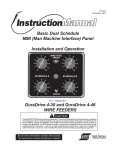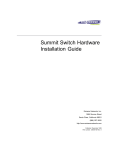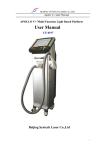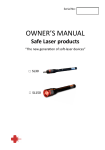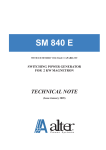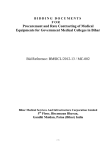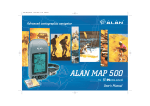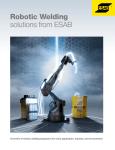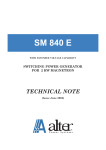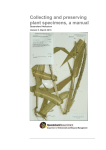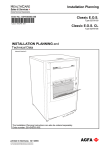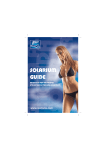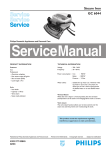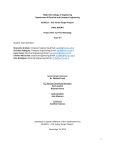Download SLIM EVOLUTION
Transcript
SLIM EVOLUTION CO2 Laser System APPLICATION MANUAL (Rev.0) Important advice for the user: This Manual provides therapeutic guidance to assist in practical therapeutic work with the SLIM EVOLUTION Laser System. The information contained herein reflects the state of the art of technology and research in this field. The editor will assume no liability for errors which, despite adequate care and attention, cannot be ruled out entirely. The user alone bears full responsibility for actions performed in conjunction with this Manual. This is no substitute for clinical judgment, „hands-on“ training with a skilled fellow clinician and personal experience. The user operates under its own responsibility, which also applies to actions correlated with the present Manual. SLIM EVOLUTION may only be used by medical personnel having a specific competence in CO2 laser systems procedures. Therefore Lasering disclaims all liability for any damages suffered by people or things. The devices produced by Lasering meet the requirements of the Medical Devices Directive 93/42/CEE acknowledged by the Italian state through the legislative decree n.46 in February 1997 (classified Class IIb) and subsequent amendments. In order to have the CE mark for its devices, Lasering applies a UNI EN ISO 9001:2000 and CEI UNI EN ISO 13485 certified Quality System for the compliance with the Annex II of the Directive. Correspondence address: Lasering S.r.l. Via Staffette Partigiane, 54 41122 - Modena Italy Tel.: +39 059 450999 Fax: +39 059 311096 All rights reserved. Most importantly, the rights to duplicate, disseminate or translate any of the information contained herein. No part of this Manual may be reproduced in any way or form (by photocopying, microfilm or any other technique) without prior written consent of the editor, nor may it be processed, duplicated or disseminated with the help of electronic systems. Rev. 0 1 Laser Safety Instructions Precautions SLIM EVOLUTION is a laser system designed, manufactured and safeguarded for surgical and therapeutical applications. As these conditions are the outcome of the initial evaluation of the equipment and consequent risks, a different use could cause damages to the equipment and be a hazard for the operators, patients and third parties. Therefore the non-observance of the technical parameters and the instructions given in the Instruction Manual of Slim Evolution, could cause abnormal running conditions which may jeopardize the equipment safety and health of the personnel. It Is the operator’s responsibility to comply with the noted precautions in order to guarantee his own safety and that of the patient. The use of accessories not manufactured by Lasering and/or not described in this Application Manual and the User Manual may release dangerous laser radiation. The service actions on this equipment shall be done by Lasering personnel only or expressly authorized by Lasering Srl. A service or an unauthorized modification of this equipment will void the warranty and may compromise the safety of the equipment. The high energy emitted from a CO2 Laser source is always a potential risk to the body and more particularly to the eyes. Improper use of the laser may cause eye damage, burns and / or injury at the tissue level. The equipment must only be utilized in a room or in an area where the access door displays the sign: Laser Control Area (Slim Evolution Instruction Manual Fig. 3.1). At the door of the room where the laser is used must fit a safety switch at a distance (Remote Interlock), in the "normally open" state related to Slim Evolution (Slim Evolution Instruction manual section 4.2). With this protection during the treatment procedure with the laser if the room door is opened, the machine will go into alarm condition and switch-off the laser source preventing the laser emission to the outside. The condition of free or denied access to the area where operates the laser equipment, must be clearly visible from the outside (red light). Rev. 0 2 Access to the area during operation of the appliance must be restricted to only authorized personnel with the obbligation of using special protective goggles (OD.7 DI.L4 a 10.600nm) marked “CE” according to the standard EN 207. The CO2 laser should always be directed only towards the treatment area. Never look straight towards the opening where it exits the laser radiation. CO2 laser emission can be reflected by many other surfaces other than those normally considered to be reflective. It is recommended that all metal objects such as watches, rings, necklaces etc. be removed from the active laser field and that only surgical instruments designed for use with CO2 lasers be used. Never use the CO2 Laser system near inflammable anesthetics and/or inflammable disinfectants. Laser plume may contain viable tissue particulates. The use of a smoke evacuation system is recommended. For any and all matters relating to safety, please follow the recommendations and regulations issued by Safety Authorities responsible for the correct use of Laser systems. Rev. 0 3 Important Considerations before the First Treatment The purpose of this Clinical Procedures Manual is to provide special application advice for the operation of this laser. It should be understood that such advice can in no way be considered to replace intensive studies of technical literature. Indeed, an adequate knowledge of the interaction between laser beam and is of fundamental importance. For this reason, we recommend the study of current literature and contact with privately practicing physicians who work with this kind of laser equipment, in order to familiarize oneself with the methods they use with the laser, before proceeding with the treatment of patients. We will gladly assist you in establishing contacts with other users. Lasering S.r.l. field/sales personnel servicing your area can provide you with full details. Check yourself if you have really understood the way the laser and the body tissue interact, the relationships between the individual application parameters and the applied technique, and the principles of laser safety. If you have the slightest doubt, consult one or more colleagues with practical experience and/or application engineers of Lasering S.r.l., before you begin laser treatment. Rev. 0 4 Introduction to Laser Technology The Laser Ever since its invention by Maiman in 1960, the laser has established itself in all branches of science and technology, and modern medicine can no longer be imagined to exist without it (first dermatological application by Goldmann in 1963). Laser is the acronym for „Light Amplification by Stimulated Emission of Radiation“. What is typical of a laser? From a practical point of view, a laser is a light source which emits a beam of tightly bundled light. This light beam has a defined wavelength (monochromaticity), and its uniform waves propagate with little divergence and in phase. Lasers exist for wavelengths ranges from ultraviolet to infra-red; laser power may vary from a few fractions of a milliwatt for medical applications to the kilowatt range for heavy-duty lasers applied in industry. Lasers differ according to wavelength, which goes from ultra-violet to infra-red, and to power, which can vary from a few fractions of a milliwatt right up to megawatts (usually found in industrial applications). Lasers exist with continuous emission, with power constant over time - “CW” -, “PULSE” lasers, where the emission of the laser beam is interrupted by a pause, (we speak of operating frequency, the higher the frequency, the closer we come to continuous emission) and “SUPERPULSE” lasers, where laser light emission is similar to that of a Pulse laser, but with the difference that the duration of the pulse is shorter compared to a Pulse emission (we speak of pulses lasting usec) and the power of each single pulse is very high (powers of around 100 - 500 watt). Finally, we also have “Q-SWITCHED” lasers with emissions similar to Superpulse emissions but with very short pulse duration (nsec) and single pulse powers of around a megawatt and more. This type of emission is made possible by the use of highly-sophisticated electronics, where laser beam obstruction is by means of extremely fast component parts. Laser Terminology ENERGY Energy is the capacity to perform work and is expressed as power multiplied by length, or as mass multiplied by speed. The unit of measurement is the Joule (J) which is 1 Watt (W) per second. Energy is usually calculated in laser surgery as power multiplied by time of application. POWER Power is the rate of performance, or flow, of energy. It is energy divided by the time of application. The unit of measurement is the Watt (W). Rev. 0 5 POWER DENSITY Power density is the rate of energy delivery per unit of target tissue area. Power density is expressed in watts per square centimeter (W/cm2) and is determined as the power divided by the surface area of the beam or spot size. Power density is the main factor which determines the speed at which the tissue is vaporized. The higher the density, the faster the tissue vaporization. ENERGY FLOW (ENERGY DENSITY) Energy flow or density represents the total energy split up in the area crossed by the beam and is expressed in joules per square cm. While the irradiation (power density) determines the speed at which the tissue is vaporised, the volume of removed tissue is an exclusive function of total applied energy. SPOT SIZE The spot size of the laser is controlled by focusing lenses inside the handpiece or by simply moving the handpiece itself toward or away from the target tissue. Fig. 1: Lens of CO2 laser allow for precise focusing on skin surface. Moving the handpiece away from the target, the beam (B) is defocalized. Rev. 0 6 It is important to realize that small variations in handpiece-to-target distance may produce dramatic alterations in the diameter of the beam or spot size and consequently in power density. A larger spot size allows for smoother, more uniform vaporization of tissue but requires that a much higher power be used to compensate for the diluition of power density over the increased area of the larger spot size. The smaller the spot size, the greater is the tendency to create uneven ridges, furrows, and bleeding. LASER PULSE Laser energy from the continuous beam of the CO2 laser can be delivered in short pulses of energy by a variety of techniques. The most common is simply mechanical shuttering the beam so that it is physically blocked for short periods, resulting in an on-off repetitive sequence of pulses. Another technique is to pulse the power supply of the operating means with a more or less long pulse train so as to likewise obtain, at output, a train of laser light pulses identical to those initially used for the supply. The Superpulse is a particular method for obtaining very short pulses but with very high powers, where the quality of the pulses depends on the goodness of the operating means. DUTY CICLE When a laser is used in pulsed mode, the active pulse duration cycle plus the duration of the pause (period during which the pulse emission is interrupted) is called duty cycle. It is usually indicated with an ON – OFF code where ON refers to the duration of the active pulse and OFF to the pause. The values of these two durations are normally expressed in percentages (E.g. ON=50% OFF=50%). TRT - THERMAL RELAXATION TIME The thermal relaxation time of tissue is the time required for the heated tissue to lose 50% of its heat through diffusion. There is no heat diffusion of any importance if the duration of the pulse is shorter than the time required by the overheated layer to cool down. The thermal relaxation time of pure water is 325 usec. The human skin has a TRT of 695 usec and in any case it is thought that an amplitude of less than 950 usec is enough to avoid heat damage of any clinical relevance. Rev. 0 7 CO2 – Laser Tissue Interaction When laser energy interacts with tissue it does so in accordance with Beer’s law. This can be simplified to the statement that tissue damage at the absorption site decreases exponentially with increasing distance from the crater edge. This means that epidermal cells at the wound edge remain viable and can participate in wound healing. According to Beer’s law, laser energy heats a critical tissue volume until the tissue temperature exceeds the vaporization threshold. If fluence is sufficient to deliver adequate energy during a single laser pulse and that pulse is less than the thermal relaxation time of tissue, then one critical volume of tissue will be cleanly vaporized with each laser pulse and without thermal damage occurring beyond the impact site. Fig. 2: Energy density determines coagulation depth On the contrary, if the Fluence used results in a pulse energy that is below the minimum necessary to vaporize tissue, tissues will coagulate, dessicate, and carbonize as heat accumulates from the additive effects of multiple pulses (or a continuous beam). When pure vaporization occurs, the temperature of the impact site of the crater is limited to 100°C (which is also water evaporation temperature). Gross carbonization is a sign that tissue temperature exceed 300°C. Additional radiation of the black carbon creates a heat sink, producing tissue temperature over 600°C. This creates extensive peripheral thermal damage secondary to thermal diffusion. Instead of a narrow zone of thermal damage of 50 to 100 um, lateral zones of thermal necrosis measuring 1 to 5 mm may result from thermal diffusion. Utilization of the CO2 laser with a pulse energy above the vaporization threshold (4-5 J/cm2) and with a pulse width less than the thermal relaxation time of skin (<1msec) results in pure steam vaporization without additional thermal energy diffusing into adjacent tissue. However, application with lower irradiances or longer pulse widths results in a gradient of thermal damage decreasing with distance from the absorption site. Rev. 0 8 Fig. 3: The degree of thermal damage depends on the vaporization rate. A: With Superpulse, thermal damage is caused by direct heating. B: With Continuous wave, an area of char appears with thermal damage caused by direct heating and damage appears also in periphery caused by heat conduction. Irradiance has been thought to be intimately related to the peripheral thermal damage and it is clear that irradiance controls the rate at which tissue is vaporized and therefore the depth of the vaporization crater. Although it is commonly advised that the highest irradiance that can be controlled should be used by the laser surgeon, this requires a rapid sweep speed with a continuous beam or a very short pulse of application. To control the depth of incision or vaporization, low power densities have been attempted. This is nonetheless particularly dangerous with the airbrush vaporization technique using a continuous beam. The ideal CO2 laser for cutaneous surgery must incise or vaporize tissue effectively and rapidly, coagulate blood vessels, and allow rapid and normal healing from adnexal structures as well as from non-treated adjacent epidermis without interfering with graft survival. The convenience of bloodless surgical technique is a very enticing concept, and the CO2 laser has been shown to be decidedly superior to both the electric knife and the scalpel in achieving hemostasis. The use of pulsed CO2 lasers has been shown to produce efficient and precise tissue ablation with decreased thermal damage to surrounding tissue. Fluence of 4 to 19 J/cm2 have been shown to produce precise tissue ablation (20-40 um of tissue removed per pulse impact) while limiting peripheral thermal damage to a zone measuring less than 100 um in thickness. Therefore the CO2 laser can most effectively vaporize cutaneous lesions if used in a pulsed mode with the pulse less than the thermal relaxation time of skin and irradiance of 1000 W/cm2 or higher. Such short exposure times and high irradiances can be achieved only with a Superpulse or with an Ultrapulse. Rev. 0 9 Clinical Application The CO2 laser can be used to cut or vaporize the tissue. These two clinical result are determined simply by the spot size and power output. Cut A high power density is decisive in order to easily cut tissue, the higher powers resulting in a deeper cut. The cut width is the same as the beam diameter. Normally, a 0,2 mm spot diameter is used for the cut. By simply moving the handpiece away from the tissue surface, the spot size enlarges or defocuses. Power density (irradiation) is essential for determining the vaporisation speed; with a largesize spot, the tissue can only vaporise quickly if the laser is able to produce a high power density. A spot size of 5 mm is about 25 times larger than a spot size of 0.2 mm and requires 625 times the power output to cut at the same speed and depth. With either low or high power densities the CO2 laser must be used with extreme care and attention. Always protect your eyes with special eyewear and, if possible, use surgical instruments that do not emit reflections; furthermore, in the operating field, use non-inflammable materials and wet gauzes and pads. During the tangential removal of new exophytic formations, the area affected by the beam must be protected during tissue cutting. The use of smoke evacuators and high efficiency filters masks is necessary to remove the smoke generated in the laser plume and avoid the possibility of contact with viral particles. Vaporization When used to vaporise tissues, the CO2 laser has the following advantages compared to other therapies: - The extreme precision achieved both in the depth and the surface of the area undergoing treatment. - The capacity to limit vaporisation to the selected objective without leaving a residual layer of undesired thermal damage. - The operating speed of the procedure. - The hemostasis during the operation. - Post-operation pain and oedema reduced to the utmost. Rev. 0 10 Two main restrictions exist. One is that the clinical point is achieved by means of visual feedback, and this can produce a fairly large error margin which depends on the surgeon’s experience. The other is that the power density and flow vary a lot, also because of small changes in operating technique. Due to these restrictions and to the low reliability of visual inspection as a means of determining the clinical stop point, a practical study is provided below as described by REID. With regard to vaporisation, he stated that the formation of opalescent bubbles on the skin surface, accompanied by a sort of very distinct crackling is a sign that only the epidermis has been removed. The surface can be cleaned with a saline solution, so it reveals an intact smooth pink surface which represents the surface of the papillary derma. When the layer is vaporised, a visible contraction of the tissue occurs with the appearance of a rough yellowish surface similar to suede leather. Once the reticular derma is reached, the connective tissue can be seen. This appears like a series of cotton threads soaked in water. Up to this point, the skin heals without any risk of scarring; if we proceed further however, this risk exists. We must also be careful of tissue carbonisation: if this occurs, we have thermal diffusion and necrosis beyond the vaporisation depth. Tissue carbonisation can be overcome by reducing the diameter of the beam. This results in an increase in flow and in vaporisation. If the lesion is not deep, the first laser stroke overheats the tissues as far as the dermisepidermis joining point. These two layers are separated naturally and the epidermis thus damaged can be removed with a gauze dampened in a saline solution. If the injury is thicker on the other hand, various strokes are needed to achieve separation of the epidermis from the dermis. This is easy to control by cleaning the wound after each stroke to ensure the layer of skin detaches easily. Rev. 0 11 CO2 Fractional Laser Some historical notes Ever since it was first introduced onto the market in 2004, the fractional concept has brought with it a significant revolution in the use of lasers in medicine. Its strong points, as the name suggests, are that instead of hitting the whole surface to be treated, only a part of this is affected, a fraction. This results in faster post-operation tissue recovery, greater comfort for the patient, less risk of side effects. Results on the other hand, from a clinical viewpoint, are comparable with those achieved using traditional “resurfacing” techniques. The first laser of this type had a wavelength of 1540nm (Er-Glass), allowed a considerable depth of penetration in the tissue and a good contraction of the collagen fibres, without however ensuring that which, from many viewpoints, is considered the major prerogative of this type of beauty treatment: skin texture. This generation of lasers did not provide, in fact, that retraction and smoothing of the epidermis required or even necessary in the treatment of particular lesions such as acne scars and deep wrinkles. For this reason, many manufacturers decided to shift their attention to other more elective wavelengths: in particular carbon dioxide CO2 as source, that which has always been deemed the wavelength best able to provide such effects on the human skin, being mainly absorbed by water and at the same time having a considerable heat effect. Even though this latter effect was the weak point of the CO2, laser, considered to be too “aggressive” compared to other laser systems, now, thanks to the fractional revolution, the CO2 laser can take on new life in view of its strong points. Lasering, on its part, boasts long-term experience in this particular sector and was the first company in the industry to introduce the concept of fractional CO2 laser with microspot (300µm) at global level. The continuous emission system (CW-CHOPPED) and the particular “Z” scan control algorithm (with separate, non-sequential dials), patented and registered, have given life to what is currently internationally recognised as the best fractional CO2 laser system in terms of manufacturing quality, patient tolerability and, above all, post-operation results. Operating principle The principle on which the MIXTO is based and which makes it so unique and particular are fundamentally two: the laser energy emission mode and how this is distributed on the skin surface. To better understand these concepts, a number of points must be explained. As previously said, by using the CO2 laser in continuous mode (CW-CHOPPED) besides the surface vaporisation of the tissue and its immediate contraction, we also have deep ablation and a heat effect that also involves the surrounding tissue, by at least another 200/500µm, depending on the power used. This heating of the papillary dermis and the induced inflammation enables us to have fibroblastic activation with consequent neo-formation collagen stimulation and a shrinkage of the collagen fibres. The depth of the laser action, employed in fractional mode, basically depends on the quantity of energy used but, if on the one hand power is limited by a surface action beyond which we no longer have an “excavation” effect, on the other, the time the laser beam remains on the point where it hits the skin becomes a crucial factor. This time, during which each single spot remains on the skin surface, is expressed by an INDEX number that goes from 8 to 1 (2.5 - 16 msec), which corresponds to the effective emission time per single spot. The times and relevant corresponding flows are indicated on table 1. Rev. 0 12 INDEX AND FLUENCE TABLE Power (Watt) Fluence Energy (J/cm²) (mJ) Fluence Energy (J/cm²) (mJ) Fluence Energy (J/cm²) (mJ) Fluence Energy (J/cm²) (mJ) Fluence Energy (J/cm²) (mJ) Fluence Energy (J/cm²) (mJ) Fluence Energy (J/cm²) (mJ) Fluence Energy (J/cm²) (mJ) 30 679,2 480 509,4 360 339,6 240 212,3 150 169,8 120 148,6 105 127,4 90 106,1 75 29 656,6 464 492,4 348 328,3 232 205,2 145 164,1 116 143,6 101,5 123,1 87 102,6 72,5 28 633,9 448 475,4 336 317 224 198,1 140 158,5 112 138,7 98 118,9 84 99,05 70 27 611,3 432 458,5 324 305,6 216 191 135 152,8 108 133,7 94,5 114,6 81 95,51 67,5 26 588,6 416 441,5 312 294,3 208 184 130 147,2 104 128,8 91 110,4 78 91,98 65 25 566 400 424,5 300 283 200 176,9 125 141,5 100 123,8 87,5 106,1 75 88,44 62,5 24 543,4 384 407,5 288 271,7 192 169,8 120 135,8 96 118,9 84 101,9 72 84,9 60 23 520,7 368 390,5 276 260,4 184 162,7 115 130,2 92 113,9 80,5 97,64 69 81,36 57,5 22 498,1 352 373,6 264 249 176 155,7 110 124,5 88 109 77 93,39 66 77,83 55 21 475,4 336 356,6 252 237,7 168 148,6 105 118,9 84 104 73,5 89,15 63 74,29 52,5 20 452,8 320 339,6 240 226,4 160 141,5 100 113,2 80 99,05 70 84,9 60 70,75 50 19 430,2 304 322,6 228 215,1 152 134,4 95 107,5 76 94,1 66,5 80,66 57 67,21 47,5 18 407,5 288 305,6 216 203,8 144 127,4 90 101,9 72 89,15 63 76,41 54 63,68 45 17 384,9 272 288,7 204 192,4 136 120,3 85 96,22 68 84,19 59,5 72,17 51 60,14 42,5 16 362,2 256 271,7 192 181,1 128 113,2 80 90,56 64 79,24 56 67,92 48 56,6 40 15 339,6 240 254,7 180 169,8 120 106,1 75 84,9 60 74,29 52,5 63,68 45 53,06 37,5 14 317 224 237,7 168 158,5 112 99,05 70 79,24 56 69,34 49 59,43 42 49,53 35 13 294,3 208 220,7 156 147,2 104 91,98 65 73,58 52 64,38 45,5 55,19 39 45,99 32,5 12 271,7 192 203,8 144 135,8 96 84,9 60 67,92 48 59,43 42 50,94 36 42,45 30 11 249 176 186,8 132 124,5 88 77,83 55 62,26 44 54,48 38,5 46,7 33 38,91 27,5 10 226,4 160 169,8 120 113,2 80 70,75 50 56,6 40 49,53 35 42,45 30 35,38 25 9 203,8 144 152,8 108 101,9 72 63,68 45 50,94 36 44,57 31,5 38,21 27 31,84 22,5 8 181,1 128 135,8 96 90,56 64 56,6 40 45,28 32 39,62 28 33,96 24 28,3 20 7 158,5 112 118,9 84 79,24 56 49,53 35 39,62 28 34,67 24,5 29,72 21 24,76 17,5 6 135,8 96 101,9 72 67,92 48 42,45 30 33,96 24 29,72 21 25,47 18 21,23 15 5 113,2 80 84,9 60 56,6 40 35,38 25 28,3 20 24,76 17,5 21,23 15 17,69 12,5 4 90,56 64 67,92 48 45,28 32 28,3 20 22,64 16 19,81 14 16,98 12 14,15 10 3 67,92 48 50,94 36 33,96 24 21,23 15 16,98 12 14,86 10,5 12,74 9 10,61 7,5 2 45,28 32 33,96 24 22,64 16 14,15 10 11,32 8 9,905 7 8,49 6 7,075 5 1 22,64 16 16,98 12 11,32 8 7,075 5 5,66 4 4,953 3,5 4,245 3 3,538 2,5 TP 16 ms 12 ms 8.0 ms 5.0 ms 4.0 ms 3.5 ms 3.0 ms 2.5 ms Index 1 2 3 4 5 6 7 8 TABLE 1 Rev. 0 13 Ways of using the apparatus and suggestions The scanning mode is also very important as it allows us to work, in many cases, without the aid of anaesthetics. This is thanks to the non-sequential arrangement of the single spots on the skin and to the fact that each subsequent spot is separated enough from the previous one so as not to create harmful heat build-up and, therefore, also pain. Different on the other hand is the superimposition of the “beneficial” heat effect inside the dermis, as shown below in fig. 4. Fig. 4 This also enables us to work with a fair amount of safety and not create any major inflammation that could produce undesired side effects (as in the case of old resurfacing treatments) such as hyper-pigmentation or scars. (fig. 5) Fig. 6, on the other hand, provides a schematic representation of the spot arrangement time sequence. Fig. 5 Rev. 0 Fig. 6 14 Spot density, meaning the coverage percentage of the treated area, can be varied from a minimum of 5% to a maximum of 40%. Obviously, this parameter appears crucial for attaining the desired result, from both a visual and therapeutic viewpoint. The possibility of varying all the parameters as required, with total flexibility, together with the various application methods, makes the fractional treatment with the Mixto laser absolutely adaptable to the various application requirements. For example, the “double scanning” technique instead of using a 40% coverage, enables us to pass twice over the area to be treated, each time with a 20% coverage but with a different rotation of the joystick so as not to superimpose the spots and make things more tolerable for the patient (fig. 7). Fig. 7 To sum up, we could say that the power and time the spot remains on the skin have a related but different effect. Through practice, different application methods can be obtained so as to achieve the best desired effect with minimum discomfort for the patient. Of course, the result also depends on the actual patient undergoing treatment: a well hydrated skin will absorb to a greater extent the wavelength of the CO2, will have greater visible effects and the down-time will be better tolerated. On the contrary, a much damaged skin, thickened and subject to photodamage will have worse results, parameters being equal. The behaviour and lifestyle of the patient are also important (smokers, those who often expose themselves to the sun or UV rays, etc.), along with predisposition to photo protect themselves and continuously hydrate the skin following in general the general rules for the preservation of a healthy skin. It is equally important to follow the suggestions of the reference doctor during post-treatment. All these factors are important and can affect all the fractional resurfacing treatment phases, and must be taken into consideration by the operator every time a patient intends undergoing such procedure. Rev. 0 15 OPERATIVE PROTOCOLS VAPORIZATION OF SUPERFICIAL LESIONS Patient preparation: Completely remove cosmetics and cleanse the skin without irritating it. It is not advisable to use local anesthetics for the treatment of small lesions Fit laser goggles and patient eye shields Use a certified smoke evacuator (with HEPA filter). Therapy parameters: Spot Functioning mode Fixed focus handpiece 5” Superpulse Average Power (W) 0,5 – 1,5 Application technique: Apply trial shots at 0,5W to optimize parameter settings and to verify the pain threshold of the patient. Increase the power if necessary and if well tolerated by the patient without anesthesia. Use the paintbrush technique on the area, tracing concentric circles or doing brushing movements on the area to be vaporized. The guideline for the treatment is the immediate vaporization of the outgrowth of the tissue until reaching the derma level. In order to uniform the rims to the surrounding tissue, refine them using some 0,5 W spots. The patients perceive a mild burning sensation, which can be reduced using the footswitch (stopping for a very short time) in order to let the tissues cool down. Aftercare: Apply an antibiotic cream on the treated area. After the post-operative reepithelization, apply a moisturizing/soothing cream. Cleanse the skin using mild soap or cleansing milk. Sunscreen post-therapeutically (strong sun blocker, approx. 6 - 10 weeks) on areas which are exposed to sunlight. Swelling and reddening may appear on the treated zone for some days. Notes: EMLA anesthesia on the area before treatment can be used on particularly painsensitive patients. Instruct the patient non to touch any scabs. The final results can be ascertained 2 – 8 weeks after the therapy. Rev. 0 16 SOLAR/SEBORRHOEIC KERATOSES Patient preparation: Completely remove cosmetics and cleanse the skin without irritating it. It is not advisable to use local anesthetics for the treatment of small lesions Fit laser goggles and patient eye shields Use a certified smoke evacuator (with HEPA filter). Therapy Parameters: Spot Functioning Mode Average Power (W) Fixed Focus Handpiece 5” Superpulse 0,5 – 1,5 Application Technique: Apply trial shot at 0,5W to optimize parameter settings and to verify the pain threshold of the patient. Increase the power if the treatment is well tolerated by the patient without anesthesia. Use the paintbrush technique on the area, tracing concentric circles or doing brushing movements on the area to be vaporized. The guideline for the treatment is the immediate vaporization of the outgrowth of the tissue until reaching the derma level. In order to uniform the rims to the surrounding tissue, refine them using some 0,5 W spots The patients perceive a mild burning sensation, which can be reduced using the footswitch (stopping for a very short time) in order to let the tissues cool down. Aftercare: Apply an antibiotic cream on the treated area. After the post-operative reepithelization, apply a moisturizing/soothing cream. Cleanse the skin using mild soap. Use a post-therapeutic sunblock lotion (high protection for ca. 6-10 weeks) Swelling and reddening may appear on the treated zone for some days. Notes: EMLA anesthesia on the area before treatment can be used on particularly painsensitive patients. Instruct the patient non to touch any scabs. The final results can be ascertained 2 – 8 weeks after the therapy. Rev. 0 17 HYPERTROPHIC SCARS Patient preparation: Completely remove cosmetics and cleanse the skin without irritating it. It is not advisable to use local anesthetics for the treatment of small lesions Fit laser goggles and patient eye shields Use a certified smoke evacuator (with HEPA filter) Therapy parameters: Spot Functioning Mode Average Power (W) Fixed focus handpiece 5” Superpulse 0,5 – 2,5 Application technique: Apply trial shot at 0,5W to optimize parameter settings and to verify the pain threshold of the patient. Increase the power if the treatment is well tolerated by the patient without anesthesia Use the paintbrush technique on the area, tracing concentric circles or doing brushing movements on the area to be vaporized As the tissues vaporize, charred tissue may form on the treated area. Wipe the char delicately with a gauze. The guideline for the treatment is the immediate vaporization of the outgrowth of the tissue until reaching the derma level. In order to uniform the rims to the surrounding tissue, refine them using some 0,5 W spots. The patients perceive a mild burning sensation, which can be reduced using the footswitch (stopping for a very short time) in order to let the tissues cool down. Aftercare: Apply an antibiotic cream on the treated area. After the post-operative reepithelization, apply a moisturizing/soothing cream. Cleanse the skin using mild soap or cleansing milk. Use a post-therapeutic sunblock lotion (high protection for ca. 6-10 weeks). Swelling and reddening may appear on the treated zone for some days. Notes: EMLA anesthesia on the area before treatment can be used on particularly painsensitive patients Instruct the patient non to touch any scabs The final results can be ascertained 2 – 8 weeks after the therapy Rev. 0 18 CONDYLOMA Patient preparation: Completely remove cosmetics and cleanse the skin without irritating it It is not advisable to use local anesthetics for the treatment of small lesions Fit laser goggles and patient eye shields Use a certified smoke evacuator (with HEPA filter). Therapy parameters: Spot Functioning Mode Average Power (W) Fixed focus handpiece 5” Superpulse 0,5 – 1,5 Application Technique: Apply trial shot at 0,5W to optimize parameter settings and to verify the pain threshold of the patient. Increase the power if the treatment is well tolerated by the patient without anesthesia (remembering that the higher the power, the higher must be the brushing speed of the operator’s hand) If the papule is very thick, it is possible to use a power up to 2 W max., reducing it little by little as the papule gets thinner, also depending on the individual sensation of pain. Use the paintbrush technique on the area, tracing concentric circles or doing brushing movements on the area to be vaporized The guideline for the treatment is the immediate vaporization of the outgrowth of the tissue until reaching the derma level. In order to uniform the rims to the surrounding tissue, refine them using some 0,5 W spots. The patients perceive a mild burning sensation, which can be reduced using the footswitch (stopping for a very short time) in order to let the tissues cool down and the burning sensation disappear. Aftercare: Apply antibiotic and antiseptic products on the treated area. During the post-operative course, a series of simple medications through the application of antiseptic products and cleansing have to be done. Sunscreen post-therapeutically (strong sun blocker, approx. 6 - 10 weeks) if the treated areas are external. Swelling and reddening may appear on the treated zone for some days. Notes: Anesthesia on the area before and during therapy can be used on pain-sensitive parts Instruct the patient non to touch any scabs The final results can be ascertained 2 – 8 weeks after the therapy. Rev. 0 19 PENDULOUS FIBROMA Patient preparation: Completely remove cosmetics and cleanse the skin without irritating it It is not advisable to use local anesthetics for the treatment of small lesions Fit laser goggles and patient eye shields Use of a certified smoke evacuator (with HEPA filter) Therapy Parameters: Spot Functioning Mode Fixed focus handpiece 5” Superpulse Average Power (W) 0,5 – 2 Application Technique: Apply trial shot at 0,5W to optimize parameter settings and to verify the pain threshold of the patient. Increase the power if well tolerated by the patient without anesthesia Use the vaporization technique on the outgrowth. If the lesion is very big, it is possible to cut its peduncle increasing the power up to 6 – 7 W slightly above the cutaneous level, and then decrease it to 0,5 – 1 W in order to uniform the rims to the surrounding tissue on the cutaneous level. As the tissues vaporize, charred tissue may form on the treated area. Wipe the char delicately with a gauze little by little as it forms. The guideline for the treatment is the immediate vaporization of the outgrowth of the tissue The patients perceive a mild burning sensation, which can be reduced using the footswitch (stopping for a very short time) in order to let the tissues cool down. Aftercare: Apply an antibiotic cream on the treated area. After the post-operative reepithelization, apply a moisturizing/soothing cream. Cleanse the skin using mild soap or cleansing milk. Sunscreen post-therapeutically (strong sun blocker, approx. 6 - 10 weeks). Swelling and reddening may appear on the treated zone for some days. Notes: EMLA anesthesia on the area before treatment can be used on particularly painsensitive patients. If cutting the peduncle is necessary, since a high emission power has to be used, apply a local anesthesia. Instruct the patient non to touch any scabs. The final results can be ascertained 2 – 8 weeks after the therapy. Rev. 0 20 BOTTLE NOSE Patient Preparation: Completely remove cosmetics and cleanse the skin without irritating it Use a nerve/block or a local anesthesia Fit laser goggles and patient eye shields Use a certified smoke evacuator (with HEPA filter) Therapy parameters: Spot Fixed focus handpiece 5” Functioning Mode Average Power (W) Superpulse 1,5 – 3,5 Application Technique: Apply trial shot at 1,5- 3,5 W to optimize parameter settings and to verify the pain threshold of the patient. If the glandular layers are very thick, the power can be increased up to 6 – 7 W in order to cut the part in excess until the nose has a normal dimension. Afterwards, the power has to be lowered to 2 – 2,5 W in order to vaporize the tissues so as to redefine the normal shape of the nose. Use the paintbrush technique on the area, tracing concentric circles or doing brushing movements on the area to be vaporized. The guideline for the treatment is the immediate vaporization of the glandular layers. The patients perceive a mild burning sensation, which can be reduced using the footswitch (stopping for a very short time) in order to let the tissues cool down and the burning sensation decrease. Aftercare: Apply antibiotic and antiseptic products. During the post-operative course, a series of simple medications through the application of antiseptic products and cleansing have to be scheduled. Use a post-therapeutic sunblock lotion (high protection for ca. 6-10 weeks) Swelling and reddening may appear on the treated zone for some days. Notes: Instruct the patient non to touch any scabs. The final results can be ascertained 2 – 8 weeks after the therapy Rev. 0 21 WARTS Patient preparation: Completely remove cosmetics and cleanse the skin without irritating it It is not advisable to use local anesthetics for the treatment of small lesions Fit laser goggles and patient eye shields Use a certified smoke evacuator (with HEPA filter) Therapy Parameters: Spot Functioning Mode Average Power (W) Fixed focus handpiece 5” Superpulse 0,5 – 2,5 Application Technique: Apply trial shot at 0,5W to optimize parameter settings and to verify the pain threshold of the patient Increase the power if well tolerated by the patient without anesthesia Use the paintbrush technique on the area, tracing concentric circles or doing brushing movements on the area to be vaporized (remembering that the higher the power, the higher must be the brushing speed of the operator’s hand) The guideline for the treatment is the immediate vaporization of the outgrowth of the tissue until reaching the derma level. In order to uniform the rims to the surrounding tissue, refine them using some 0,5 W spots. As the tissues vaporize, charred tissue may form on the treated area. Wipe the char delicately with a gauze. The wart rim has to be vaporized ca. 1 mm more than the size of wart itself. The patients perceive a mild burning sensation, which can be reduced using the footswitch (stopping for a very short time) in order to let the tissues cool down Aftercare: Apply an antibiotic cream on the treated area. During the post-operative period, apply an antibiotic/antiseptic cream. Cleanse the skin using mild soap. Sunscreen post-therapeutically (strong sun blocker, approx. 6 - 10 weeks) on areas which are exposed to sunlight Swelling and reddening may appear on the treated zone for some days. Notes: EMLA anesthesia on the area before treatment can be used on particularly painsensitive patients. Instruct the patient not to touch any scabs. The final results can be ascertained 2 – 8 weeks after the therapy Rev. 0 22 MOLES Patient preparation: Histological examination for diagnosis before removal. It is not advisable to use local anesthetics for the treatment of small lesions. Fit laser goggles and patient eye shields Use a certified smoke evacuator (with HEPA filter) Therapy Parameters: Spot Functioning Mode Average Power (W) Fixed focus handpiece 5” Superpulse 0,5 – 2,5 Application Technique: Apply trial shot at 0,5W to optimize parameter settings and to verify the pain threshold of the patient. Increase the power if necessary and if well tolerated by the patient without anesthesia. Use the paintbrush technique on the area, tracing concentric circles or doing brushing movements on the area to be vaporized. If the mole has big dimensions, it is possible to cut it increasing the power up to 6 – 7 W slightly above the skin level and then decrease it to 0,5 – 1 W in order to reach an ablation depth which reaches the papillary dermis level. As the tissues vaporize, charred tissue may form on the treated area. Wipe the char delicately with a gauze. The guideline for the treatment is the immediate vaporization of the outgrowth of the tissue. The patients perceive a mild burning sensation, which can be reduced using the footswitch (stopping for a very short time) in order to let the tissues cool down. Aftercare: Apply an antibiotic cream on the treated area. During the post-operative course, a series of simple medications through the application of antiseptic products and cleansing have to be scheduled. Sunscreen post-therapeutically (strong sun blocker, approx. 6 - 10 weeks)on areas which are exposed to sunlight Swelling and reddening may appear on the treated zone for some days. Notes: EMLA anesthesia on the area before treatment can be used on particularly painsensitive patients. In case of surgical cut, it is necessary to use a local anesthesia Instruct the patient non to touch any scabs The final results can be ascertained 2 – 8 weeks after therapy. Rev. 0 23 SURGICAL SCANNER (Traditional mode with 100% coverage) FACE RESURFACING Patient Preparation: This type of operation must only be performed with the patient totally sedated. Do not perform this type of operation on tanned patients and, in any case, never beyond phototype IV (Fitzpatrick scale). It is best to perform anti-herpes treatment, above all in persons subject to herpes. The operator and any assistants must wear protective eyewear. The patient must wear dedicated protections. Use a certified smoke evacuator (with HEPA filter) Thepary parameters: Spot Exposure time µs (microseconds) Power (Watt) Scanner Handpiece 300 14 – 20 Application Technique: Work with the maximum dimension (20x20mm) on the forehead and in areas where this is possible. Gradually reduce the dimension or change the shape to adapt to the morphology of the face, avoiding superimposing spots beyond 10% Do not make double strokes. Do not remove the layer of necrosis of each stroke. Aftercare: Apply an antibiotic cream on the treated area. Until complete healing/re-epithelizing constantly apply vaseline or other highlymoisturising ointments and which must never contain perfumed, irritating and allergenic substances. During this period, the patient must avoid exposing him/herself to sunlight and, in any case, never without due protection and never before re-epithelizing has occurred. During the above period, the patient will have a strong erythema which could persist for 2/3 weeks, and a widespread oedema for 7/10 days, more accentuated in the delicate areas around the eyes, lips and chin. Once healing has occurred, continue with the application of moisturising cream, possibly also with restructuring power, in a continuative way, for another 3 months until total healing has occurred. A high-protection sun shield, for the entire healing period (about 6 months), is to be considered mandatory. Rev. 0 24 PEELING Patient preparation: This type of operation does not envisage sedation or special requirements and is normally well tolerated by any patient. Do not perform this type of operation on tanned patients and, in any case, never beyond phototype IV (Fitzpatrick scale). It is best to perform anti-herpes treatment, above all in persons subject to herpes. The operator and any assistants must wear protective eyewear. The patient must wear dedicated protections. Use a certified smoke evacuator (with HEPA filter) Therapy parameters: Spot Exposure time µs (microseconds) Power (Watt) Scanner Handpiece 100 12 – 15 Application Technique: Adapt the scanning dimension to the lesion to be treated. Gradually reduce the dimension or change the shape to adapt to the morphology of the face, avoiding superimposing spots beyond 10% Do not make double strokes. Do not remove the layer of necrosis of each stroke. In some cases, where necessary, a second stroke can be made. Aftercare: Apply an antibiotic cream on the treated area. Until complete healing/re-epithelizing constantly apply vaseline or other highly-moisturising ointments and which must never contain perfumed, irritating and allergenic substances During this period, the patient must avoid exposing him/herself to sunlight and, in any case, never without due protection and never before re-epithelizing has occurred. During the above period, the patient will have an erythema of variable entity, which could persist for some days, and a possible oedema in the delicate areas around the eyes, lips and chin. Once healing has occurred, continue with the application of moisturising cream, possibly also with restructuring power, in a continuative way, for another 20/30 days. A high-protection sun shield, for the entire healing period (about 6 months), is to be considered mandatory. Notes: Topical anesthesia with anesthetic cream on the area to be treated, however not advised for, can be used on particularly pain-sensitive patients. It is anyway to be considered that, in this case, the treatment effectiveness and, thus, its result might be compromised. Instruct the patient non to touch any scabs. The final results can be ascertained 2/3 months after therapy. Rev. 0 25 SKIN SPOTS, KERATOSIS, LENTIGO Patient preparation: This type of operation does not envisage sedation or special requirements and is normally well tolerated by any patient. Do not perform this type of operation on tanned patients and, in any case, never beyond phototype IV (Fitzpatrick scale). The operator and any assistants must wear protective eyewear. The patient must wear dedicated protections. Use a certified smoke evacuator (with HEPA filter) Therapy parameters: Spot Exposure time µs (microseconds) Power (Watt) Scanner handpiece 100 12 – 14 Application Technique: Adapt the scanning dimensions to the area and the lesion to be treated. Start with the lowest power and increase with steps of 1 Watt until the desired end point is achieved (uniform white/greyish ablation) Perform several strokes until the lesion has been flattened. Do not remove the layer of necrosis of each stroke. In some cases, where necessary, a second stroke can be made. Aftercare: Apply an antibiotic cream on the treated area. We advise leaving the ablation layer intact, as this will also act as a “biological barrier”. This will become a slight scab that will fall off in a few days. During this period, avoid continuous washing of the area and never remove the scabs. Once healing has occurred, apply a moisturising cream, possibly also with restructuring power, in a continuative way, until total healing has occurred Sunscreen post-therapeutically (strong sun blocker) during the whole period of treatment. Notes: Topical anesthesia with anesthetic cream on the area to be treated, however not advised for, can be used on particularly pain-sensitive patients. It is anyway to be considered that, in this case, the treatment effectiveness (with the above parameters) and, thus, its result might be compromised. Instruct the patient not to touch any scabs. The final results can be ascertained after 2-3 weeks. Rev. 0 26 SURGICAL SCANNER (Mixto Sx Fractional mode with coverage 5 - 40%) FACE REFRESHING Patient preparation: This type of operation does not envisage sedation or special requirements and can be performed anywhere. Do not perform this type of operation on tanned patients. It is best to perform anti-herpes treatment, above all in persons subject to herpes. The operator and any assistants must wear protective eyewear. The patient must wear dedicated protections. Use a certified smoke evacuator (with HEPA filter). Therapy Parameters: Spot Index Power W(watt) Density (coverage %) 300µm 8 8 20 Application Technique: Work with the maximum dimension (20x20mm) on the forehead and in areas where this is possible. Gradually reduce the dimension or change the shape to adapt to the morphology of the face. A moderate superimposition of the spots (not more than 20%) is to be considered desirable. Make a second stroke, inclining the axis of the handpiece by 45° with respect to the previous inclination Do not remove the layer of necrosis of each stroke. Aftercare: Apply an antibiotic cream on the treated area. Until complete healing/re-epithelizing constantly apply a highly-moisturising and protective ointment which must never contain perfumed, irritating and allergenic substances During this period, the patient must avoid exposing him/herself to sunlight. During the above period, the patient will have a strong erythema which could persist for 2/3 days and a widespread oedema for 24/48 hours more accentuated in the delicate areas. Once healing has occurred, continue with the application of moisturising cream, possibly also with restructuring power, in a continuative way, for another 3 months. A high-protection sun shield, for the entire healing period (about 60 days), is mandatory. Note: Topical anesthesia with anesthetic cream on the area to be treated, however not advised for, can be used on particularly pain-sensitive patients. It is anyway to be considered that, in this case, the treatment effectiveness (with the above parameters) and, thus, its result might be compromised. Instruct the patient not to touch any scabs. The final results can be ascertained 8/10 days after the therapy. Rev. 0 27 FACE WRINKLES Patient Preparation: This type of operation does not envisage sedation or special requirements and can be performed anywhere. Do not perform this type of operation on tanned patients. It is best to perform anti-herpes treatment, above all in persons subject to herpes. The operator and any assistants must wear protective eyewear. The patient must wear dedicated protections. Use a certified smoke evacuator (with HEPA filter) Therapy Parameters: Spot Index Power W(watt) Density (coverage %) 300µm 8-6 8-12 20 180µm 8-7 4-8 10/15 Application Technique: Work with the maximum dimension (20x20mm with 300 µm insert or 12x12mm with 180 µm insert) on the forehead and in areas where this is possible. Gradually reduce the dimension or change the shape to adapt to the morphology of the face. A moderate superimposition of the spots (not more than 20%) is to be considered desirable. Make a second stroke, inclining the axis of the joystick by 45° with respect to the previous inclination. Do not remove the layer of necrosis of each stroke. Aftercare: Apply an antibiotic cream on the treated area. Until complete healing/re-epithelizing constantly apply a highly-moisturising ointment which must never contain perfumed, irritating and allergenic substances During this period, the patient must avoid exposing him/herself to sunlight During the above period, the patient will have a strong erythema which could persist for 2/3 days, and a widespread oedema for 24/48 hours, more accentuated in the delicate areas around the eyes, lips and chin. Once healing has occurred, continue with the application of moisturising cream, possibly also with restructuring power, in a continuative way, for another 3 months. A high-protection sun shield, for the entire healing period (about 60 days), is to be considered mandatory. Notes: Topical anesthesia with anesthetic cream on the area to be treated, however not advised for, can be used on particularly pain-sensitive patients. It is anyway to be considered that, in this case, the treatment effectiveness (with the above parameters) and, thus, its result might be compromised. Instruct the patient not to touch any scabs. The final results can be ascertained 8/10 days after the therapy. Rev. 0 28 ACNE AND NON-ACNE SCARS Patient preparation: This type of operation does not envisage sedation or special requirements and can be performed anywhere. Do not perform this type of operation on tanned patients. It is best to perform anti-herpes treatment, above all in persons subject to herpes. The operator and any assistants must wear protective eyewear. The patient must wear dedicated protections. Use a certified smoke evacuator (with HEPA filter) Therapy Parameters: Spot Index Power W(watt) Density (coverage %) 300µm 180µm 8-6 8-7 8-12 4-8 20 10/15 Application Technique: Work with the maximum dimension (20x20mm with 300 µm insert or 12x12mm with 180 µm insert) on the forehead and in areas where this is possible. Gradually reduce the dimension or change the shape to adapt to the morphology of the face. A moderate superimposition of the spots (not more than 20%) is to be considered desirable. Make a second stroke, inclining the axis of the joystick by 45° with respect to the previous inclination. Do not remove the layer of necrosis of each stroke. Aftercare: Apply an antibiotic cream on the treated zone. Until complete healing/re-epithelizing constantly apply a highly-moisturising ointment which must never contain perfumed, irritating and allergenic substances. During this period, the patient must avoid exposing him/herself to sunlight. During the above period, the patient will have a strong erythema which could persist for 2/3 days, and a widespread oedema for 24/48 hours, more accentuated in the delicate areas around the eyes, lips and chin Once healing has occurred, continue with the application of moisturising cream, possibly also with restructuring power, in a continuative way, for another 3 months. A high-protection sun shield, for the entire healing period (about 60 days), is to be considered mandatory. Notes: Topical anesthesia with anesthetic cream on the area to be treated, however not advised for, can be used on particularly pain-sensitive patients. It is anyway to be considered that, in this case, the treatment effectiveness (with the above parameters) and, thus, its result might be compromised. Instruct the patient not to touch any scabs. The final results can be ascertained 8/10 days after the therapy. Rev. 0 29 PERIORAL WRINKLES (BAR CODE) Patient Preparation: This type of operation does not envisage sedation or special requirements and can be performed anywhere. Do not perform this type of operation on tanned patients. It is best to perform anti-herpes treatment, above all in persons subject to herpes. The operator and any assistants must wear protective eyewear. The patient must wear dedicated protections. Use a certified smoke evacuator (with HEPA filter) Therapy parameters: Spot Index Power W(watt) Density (coverage %) 300µm 8-6 8-12 15/20 180µm 8-7 4-8 10/15 Application Technique: Work with the dimension which best fits the area to be treated. Manually extend the skin in the treated area in order to make the action of the laser penetrate the grooves. Gradually reduce the dimension or change the shape to adapt to the morphology of the face. A moderate superimposition of the spots (not more than 20%) is to be considered desirable. Because the area is very sensitive to pain, the percentage of coverage can be reduced and several crossover strokes made. Do not remove the layer of necrosis of each stroke. Aftercare: Apply an antibiotic cream on the treated zone. Until complete healing/re-epithelizing constantly apply a highly-moisturising ointment which must never contain perfumed, irritating and allergenic substances. During this period, the patient must avoid exposing him/herself to sunlight. During the above period, the patient will have a strong erythema which could persist for 2/3 days, and a widespread oedema for 24/48 hours. Once healing has occurred, continue with the application of moisturising cream, possibly also with restructuring power, in a continuative way, for another 3 months. A high-protection sun shield, for the entire healing period (about 60 days), is to be considered mandatory. Notes: Topical anesthesia with anesthetic cream on the area to be treated, however not advised for, can be used on particularly pain-sensitive patients. It is anyway to be considered that, in this case, the treatment effectiveness (with the above parameters) and, thus, its result might be compromised. Instruct the patient not to touch any scabs. The final results can be ascertained 10/12 days after the therapy. Rev. 0 30 PERIORBITAL WRINKLES (AROUND THE EYES) Patient preparation: This type of operation does not envisage sedation or special requirements and can be performed anywhere. Do not perform this type of operation on tanned patients. It is best to perform anti-herpes treatment, above all in persons subject to herpes. The operator and any assistants must wear protective eyewear. The patient must wear dedicated protections. Use a certified smoke evacuator (with HEPA filter) Therapy Parameters: Spot Index Power W(watt) Density (coverage %) 300µm 8-7 8-12 10/20 180µm 8-7 4-8 10/15 Application Technique: Work with the dimension which best fits the area to be treated. Manually extend the skin in the treated area in order to make the action of the laser penetrate the grooves. Gradually reduce the dimension or change the shape to adapt to the morphology of the face. A moderate superimposition of the spots (not more than 20%) is to be considered desirable. Because the area is very sensitive to pain, the percentage of coverage can be reduced and several crossover strokes made. Do not remove the layer of necrosis of each stroke. Aftercare: Apply an antibiotic cream on the treated zone. Until complete healing/re-epithelizing constantly apply a highly-moisturising ointment which must never contain perfumed, irritating and allergenic substances. During this period, the patient must avoid exposing him/herself to sunlight. During the above period, the patient will have a strong erythema which could persist for 2/3 days, and a widespread oedema for 24/48 hours. Once healing has occurred, continue with the application of moisturising cream, possibly also with restructuring power, in a continuative way, for another 3 months. A high-protection sun shield, for the entire healing period (about 60 days), is to be considered mandatory. Notes: Topical anesthesia with anesthetic cream on the area to be treated, however not advised for, can be used on particularly pain-sensitive patients. It is anyway to be considered that, in this case, the treatment effectiveness (with the above parameters) and, thus, its result might be compromised. Instruct the patient not to touch any scabs. The final results can be ascertained 10/12 days after the therapy. Rev. 0 31 NECK - DÉCOLLETÉ - HANDS Patient preparation: This type of operation does not envisage sedation or special requirements and can be performed anywhere. Do not perform this type of operation on tanned patients. It is best to perform anti-herpes treatment, above all in persons subject to herpes. The operator and any assistants must wear protective eyewear. The patient must wear dedicated protections. Use a certified smoke evacuator (with HEPA filter) Therapy Parameters: Spot Index Power W(watt) Density (coverage %) 300µm 8 8 15 - 20 Application Technique: Work with the maximum dimension (20x20mm with 300 µm insert) where it is tolerated. A moderate superimposition of the spots (not more than 20%) is to be considered desirable. Do not remove the layer of necrosis of each stroke. Aftercare: Apply an antibiotic cream on the treated zone. Until complete healing/re-epithelizing constantly apply a highly-moisturising ointment which must never contain perfumed, irritating and allergenic substances. During this period, the patient must avoid exposing him/herself to sunlight and, in any case, never without due protection and never before re-epithelizing has occurred. During the above period, the patient will have a strong erythema which could persist for 2/3 days, and a widespread oedema for 24/48 hours. Once healing has occurred, continue with the application of moisturising cream, possibly also with restructuring power, in a continuative way, for another 3 months. A high-protection sun shield, for the entire healing period (about 60 days), is to be considered mandatory. Notes: Topical anesthesia with anesthetic cream on the area to be treated, however not advised for, can be used on particularly pain-sensitive patients. It is anyway to be considered that, in this case, the treatment effectiveness (with the above parameters) and, thus, its result might be compromised. Instruct the patient not to touch any scabs. The final results can be ascertained 10/12 days after the therapy Rev. 0 32 LASERING S.r.l. Via Staffette Partigiane 54 41122 MODENA (MO) - ITALY Tel. +39 059 450999 Fax +39 059 311096 E-mail: [email protected] www.lasering.it Rev. 0 33


































